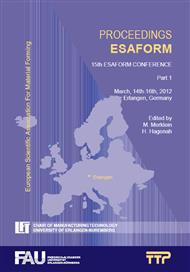p.71
p.77
p.83
p.89
p.95
p.101
p.107
p.113
p.119
Study of True Stress-Strain Curve after Necking for Application in Ductile Fracture Criteria in Tube Hydroforming of Aerospace Material
Abstract:
Tube hydroforming (THF) is an advanced metal forming process that is used widely in automotive industry, but the application of the THF process in aerospace field is comparatively new with many challenges due to high strength and limited formability of aerospace materials. The success of THF process largely depends on many factors, such as mechanical properties of the material, loading path during the process, tool geometry and friction condition. Due to complexity of this process, finite element modeling (FEM) can largely reduce the production cost. One of the important input in FEM is the material behavior during hydroforming process. The true stress-strain curve before necking can be easily determined, using either tensile testing or bulge testing, but for an accurate failure prediction in a large deformation, such as hydroforming, the study of true stress-strain curve after necking is important because it improves the quality of the analysis due to utilizing a real extended stress-strain curve. Hence, the objective of this research was to establish a methodology to determine the true stress-strain curve after necking in order to predict burst pressure in the THF of aerospace materials. Uniaxial tensile tests were performed on standard tensile samples (ASME E8M-04) to determine the true stress-strain before and after necking, using an analytical method presented in this study. To validate the approach, burst pressure in the THF process was predicted using the extended stress-strain curve in conjunction with Brozzo's decoupled fracture model. The approach was evaluated using data obtained from the free expansion (tube bulging) tests performed on stainless steel 321 tubes with 2 inches diameter and two different thicknesses, 0.9 mm and 1.2 mm. The comparison of the predicted and measured burst pressures was promising, indicating that the approach has the potential to be extended to predict formability limits in THF of complex shapes.
Info:
Periodical:
Pages:
95-100
Citation:
Online since:
February 2012
Price:
Сopyright:
© 2012 Trans Tech Publications Ltd. All Rights Reserved
Share:
Citation:


